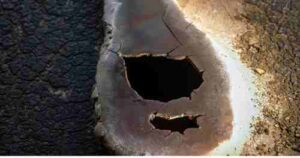Table of Contents
Welding is a vital part of making things from metal, but it’s not always smooth sailing. One big issue welders face is something called “Crater Crack in Welding.” In this article, we’ll dig into what crater cracks are, what causes them, and why they matter. We’ll also learn how to stop them from happening and how to fix them if they do. Plus, we’ll clear up some myths and share real stories. Ready to explore the world of welding and uncover the secrets of crater cracks?

What is Crater Crack in Welding
A crater crack in welding is a small but potentially damaging crack that can form at the end of a weld when it cools down. It’s a common challenge in welding that can weaken the weld’s strength.
Understanding Welding Crater Cracks
Definition of Crater Cracks
Crater cracks, in the context of welding, are small, often microscopic, cracks that form at the end of a weld bead, particularly when the welding arc is extinguished or as the weld cools down. These cracks are known for their potential to compromise the structural integrity of the weld.
Causes of Crater Cracks
To understand crater cracks better, it’s essential to know what leads to their formation. Factors contributing to crater cracks include:
- Rapid Cooling: As the molten weld pool cools rapidly during the welding process, it can cause contraction and create stress, leading to cracks.
- Hydrogen Embrittlement: The presence of hydrogen in the welding process can increase the likelihood of cracks.
- Improper Techniques: Inadequate welding techniques or incorrect settings can exacerbate the formation of crater cracks.
Importance of Addressing Crater Cracks
Why should welders be concerned about crater cracks? The significance lies in the potential consequences.
- Structural Weakness: Crater cracks weaken the weld, potentially compromising the structural integrity of the workpiece.
- Risk of Failure: Over time, the presence of crater cracks can lead to weld failure, with potentially hazardous consequences.
Preventing Crater Cracks
Preventing crater cracks is crucial for producing strong, reliable welds. Welders employ various techniques to minimize their occurrence, such as crater filling and controlling cooling rates.
Detecting Crater Cracks
Detecting crater cracks is essential for quality control. Visual inspection and non-destructive testing methods are commonly used to identify these cracks.
Repairing Crater Cracks
If crater cracks are detected, they need to be addressed promptly. The repair process involves several steps to ensure the weld’s integrity.
Common Myths About Crater Cracks
Let’s dispel some common misconceptions surrounding crater cracks. Understanding the truth is essential for effective welding.
Real-world Examples
To provide a practical perspective, we’ll look at real-world cases where crater cracks played a significant role and how they were managed.
Conclusion
In conclusion, crater cracks in welding are a critical issue that welders must address to ensure the strength and reliability of their welds. Understanding the causes, prevention methods, detection techniques, and repair processes is vital for producing high-quality welds and maintaining safety standards.
Welding cracks and their types
FAQs
1. Can crater cracks be seen with the naked eye?
- Crater cracks are often microscopic and may not be visible without magnification.
2. Are all welding processes prone to crater cracks?
- While crater cracks can occur in various welding processes, their likelihood depends on factors such as welding parameters and materials used.
3. Can crater cracks be repaired in all cases?
- Crater cracks can be repaired in many cases, but the success of the repair depends on factors like crack size and location.
4. Are crater cracks the same as other types of welding defects?
- No, crater cracks are a specific type of defect that occurs at the end of a weld bead, whereas other defects may occur elsewhere in the weld.
5. How can I prevent crater cracks in my welding projects?
- Preventing crater cracks involves proper welding techniques, controlling cooling rates, and using appropriate materials and settings.
By understanding and addressing crater cracks, welders can enhance the quality and safety of their work, ensuring that welded structures and components remain reliable over time.


6 thoughts on “What is Crater Crack in Welding?”